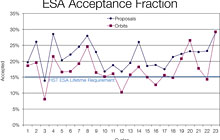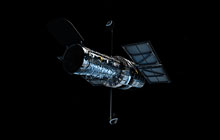Editorial
Dear Colleagues,
The last few months have been very exciting ones. On 24 April, we celebrated the 25th anniversary of Hubble’s launch. And what a celebration it was!
As part of the anniversary celebrations we dedicated an entire symposium to the science that is being done with Hubble, with a special focus on what the next five years could bring. In spite of its mature age, Hubble is going strong and the expectations are that it will be a powerful observatory well into the 2020s. We are planning for at least a couple of years of scientific overlap with the James Webb Space Telescope, which is planned for launch in 2018. It was for this reason that for the conference — Hubble 2020: Building on 25 Years of Discovery — we asked you what the future Hubble legacy should be. Additional details on the symposium can be found in this newsletter.
In parallel, the Space Telescope Science Institute (STScI), after extensive discussions with the Space Telescope User Committee (STUC), also solicited direct input from you all to aid us in determining how best to structure the next five years of Hubble observations, via a Call for White Papers. Numerous papers were received, and that input, combined with your contributions to the Hubble 2020 symposium will be used to inform the Hubble observing strategies for the years to come. Stay tuned!
In addition, on 23 April, a very special anniversary image was unveiled: a stunning multi-wavelength view of the young galactic stellar cluster Westerlund 2. Over 70 large prints of Westerlund 2 are being showcased all over Europe as part of an initiative to get the Hubble birthday party going with synchronised unveiling ceremonies in museums, planetariums, auditoriums and streets. Find out more about this, and the other public celebrations of Hubble, in this newsletter, a testimony to the fact that Hubble remains the much-loved “People’s Telescope”.

|
6 July 2015: Wednesday 24 June was a day that all Hubble observers both long for and fear, as it is the day when notifications go out to the successful Principal Investigators (PIs), letting them know that their programme has beaten the scientific oversubscription odds and that they will now be very busy completing the Phase II instructions needed to schedule their observations ...
|
| Read more |

|
6 July 2015: The ESA/Hubble Ode to Hubble competition was an opportunity for those inspired by Hubble to get creative and produce short videos in celebration of Hubble’s 25th anniversary on 24 April 2015.
The competition has now closed but for those of you who work on Hubble there is still a lot to gain from it. We hope you will ...
|
| Read more |

|
6 July 2015: On 23 April Hubble's 25th year in orbit was celebrated by NASA and ESA with the release of a special anniversary image of the star cluster Westerlund 2. To promote this event to the public and share the stunning image with as many people as possible ESA/Hubble organised the printing and distribution of 70 large-scale prints to be ...
|
| Read more |

|
6 July 2015: Every year, the STScI organises a spring symposium on a topic of high scientific interest. This year, as we celebrated Hubble’s splendid 25 years in space, it seemed appropriate to dedicate the symposium to the amazing science done using the Hubble Space Telescope in its lifetime.
As they were pondering the title for the symposium, the Science Organizing Committee ...
|
| Read more |

|
6 July 2015: In the autumn of 2015 the Archives Group at the European Space Astronomy Centre (ESAC) will release the new European Hubble archive.
More information will follow in our next newsletter, but you can expect several key new features — some of which are not available anywhere else — including:
Online visualisation and inspection of 1D spectra.
Online visualisation and inspection of full ...
|
| Read more |